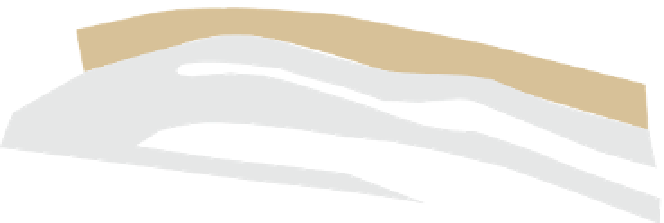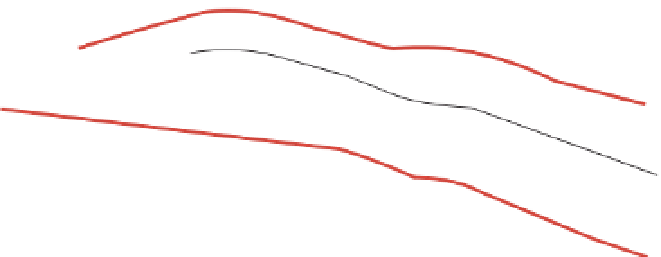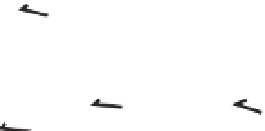Geology Reference
In-Depth Information
ramps
Figure 5.7
Thrust faults in profile.
A.
Thrusts in layered rocks usually
follow bedding planes (flats) for part
of their course, then cut up through
the beds on a ramp structure.
B.
The result of this flat/ramp geometry
is that the thrust sheet forms folds
to accommodate to it; synforms are
caused by ramps in the footwall,
and antiforms where hangingwall
ramps overlie a flat.
C.
Simplified
diagrammatic W-E cross-section
through part of the Moine thrust
zone of NW Scotland, showing how
successive thrust sheets (termed
nappes) bring older, deeper, rocks
from further east upwards towards
the west. One of the nappes is
made up of slices of bedded
Cambrian rocks bounded by steep
reverse faults; this is termed an
imbricate structure (
D
).
E.
Enlarged
part of the imbricate nappe
showing how each slice is formed
by bedding being pushed along
the basal thrust and up the steep
reverse faults. BQ, basal quartzite;
DL, Durness limestone.
flat
5
thrust
A
B
36
37
thrusts
imbricate
zone
Ben More
nappe
Moine
schists
lower
nappe
Cambrian
beds
basement
sole
thrust
Lewisian
basement
C
DL
basement
D
E
of mountain belts that typically display
major thrust zones of this type, known
as foreland fold-thrust belts. Such zones
generally follow a pattern in which the
outer thrust sheets are formed from
bedded rocks of the
foreland
(the region
outside the mountain belt), whereas
further inwards towards the interior
of the belt, they are replaced by much
larger thrust sheets derived from deeper
levels of the crust, as in Figure 5.7C. The
latter are often quite different from the
foreland rocks and include metamor-
phic rocks strongly altered by heat and
high pressure, since the thrusts have
reached down towards the base of the
crust. It is because of this that we are
able to study rocks formed at depths of
up to 80 kilometres beneath the surface.
form a branching network. Because
only a short section of a particular fault
is active at any given time, the oppo-
site movements of the blocks on either
side create zones of compression or
extension at the ends of the moving
blocks. Subsidiary structures such as
normal faults may be formed in the
extended zones and reverse faults in
the compressed zones. Another com-
plication may arise at bends in the
main fault. At such bends, the fault is
oblique to the main direction of move-
ment, creating zones of compression or
extension respectively (Figure 5.8B, C).
Active or recent strike-slip fault zones
such as the San Andreas are typified
Strike-slip fault systems
Strike-slip faults (also known as
wrench
faults
) are typically vertical or steeply
inclined and separate blocks of crust
that have moved past each other in
opposite directions in a sub-horizontal
direction (see Figure 5.3C). Sets of such
faults are typical of conservative plate
boundaries, of which perhaps the best-
known example is the
San Andreas fault
in western USA (Figure 5.8A - see also
Figure 3.6). This structure is actually a
fault zone up to 100 kilometres wide
containing many individual faults that












































Search WWH ::

Custom Search